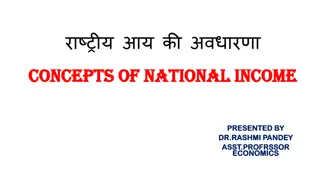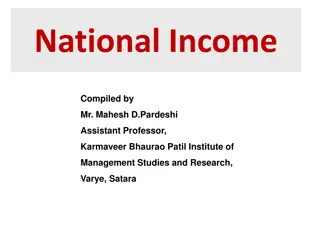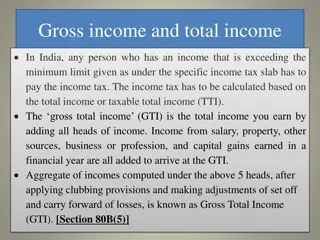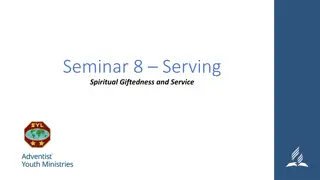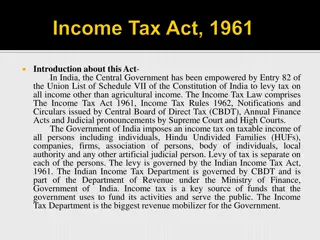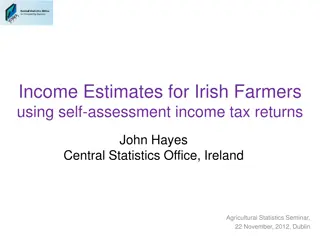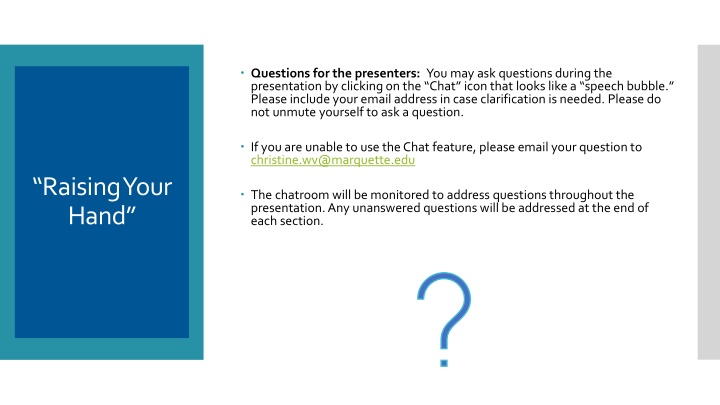
Achieving Clients' Goals with Split Income Gifts: Overview & Case Studies
Learn about life-income and split-interest gifts, including trusts, charitable annuities, and donor goals in achieving wealth transfer objectives. Explore the background, definition, and characteristics of split income gifts for effective planned giving strategies.
Download Presentation

Please find below an Image/Link to download the presentation.
The content on the website is provided AS IS for your information and personal use only. It may not be sold, licensed, or shared on other websites without obtaining consent from the author. If you encounter any issues during the download, it is possible that the publisher has removed the file from their server.
You are allowed to download the files provided on this website for personal or commercial use, subject to the condition that they are used lawfully. All files are the property of their respective owners.
The content on the website is provided AS IS for your information and personal use only. It may not be sold, licensed, or shared on other websites without obtaining consent from the author.
E N D
Presentation Transcript
Questions for the presenters: You may ask questions during the presentation by clicking on the Chat icon that looks like a speech bubble. Please include your email address in case clarification is needed. Please do not unmute yourself to ask a question. If you are unable to use the Chat feature, please email your question to christine.wv@marquette.edu Raising Your Hand The chatroom will be monitored to address questions throughout the presentation. Any unanswered questions will be addressed at the end of each section.
Presented on behalf of Marquette University Law School Achieving Clients Goals with Split Income Gifts: Background and Case Studies by Cathy Steinhafel, L 89, Sr. Director of Development, Planned Giving Marquette University and Katie Hofman, DePaul Law 87 Associate Vice President, Planned Giving Marquette University June 3, 2020
Background on Split Income Gifts Life-income/split-interest gifts: value in the property is split between two components: the lead or income interest; and the remainder interest charity and non-charities (individuals) are beneficiaries of the split interests Full menu of irrevocable split-interest gifts include: Trusts Charitable lead trusts (CLS)* Charitable remainder trusts (CRTs)* Pooled income funds Non-trusts/Contract Charitable gift annuities (CGAs)* Remainder interest in residence or farm Donor goals determine the vehicle to suggest Income stream from gift CGA or CRT Transfer wealth to heirs - CLT
Definition: an irrevocable CONTRACT between the Donor(s) and Charity Donor transfers cash or other property to Charity (part gift / part purchase of annuity contract) in exchange for Charity s promise to pay a guaranteed fixed dollar amount to the donor or other annuitants for life (lead interest) Upon the death of the Annuitant, any remaining amount belongs to Charity (remainder interest a/k/a residuum). Charitable Gift Annuities Four parties to a CGA: Donor(s), Charity, Annuitant(s) and State Commissioner of Insurance Payments can begin immediately or can be deferred to a flexible or specific future date, which must be more than one year after date of contribution (higher payout rates if deferred) Payment obligation is a general obligation of Charity (not limited to the contributed assets or segregated fund), secured by all unrestricted assets of the Charity Because Charity is acting as administrator and insurer of the annuity contract, WI requires it to maintain investment reserves
Characteristics: Charity s obligation to pay continues beyond the annuitant s projected life expectancy, even if Charity has to dip into its own assets to make payments. Charitable Gift Annuities Donors cannot add money to the gift after it is created. They must establish another CGA. Upon the death of the sole or surviving annuitant, any residuum can be removed from the reserve funds and used by Charity for purposes originally specified by the donor in the contract. The insurance laws of the state of the Donor s principle residence control the requirements for each CGA issued by Charity. Charities gift acceptance policies may have minimum age and dollar amount requirements (i.e. MU requires a minimum gift of $10,000 for annuitants older than 60 and $25,000 for annuitants between 50-60. Minimums for deferred CGAs considered case by case.)
CGA Annuitants: Single life: pay only one person for their lifetime Joint and survivor: pay 2 people simultaneously with both names on annuity check, each getting the payment. When the first dies, the survivor receives full annuity payment. Two lives in succession: Pay person A and if B survives A, pay person B Charitable Gift Annuities The maximum number of annuitants allowed is always two Size of CGA payments depends on the following four factors: The gift annuity rate offered by the charity (see www.acga-web.org for current and upcoming ACGA rates declining on July 1, 2020) The value of the contribution The number of annuitants The ages(s) of the annuitant(s)
ACGA Rates: The recommended rates are computed to produce an average residuum to the charity at the expiration of the agreement of 50% of the original gift. Charitable Gift Annuities In order to preserve the gift portion of the annuity, rates are lower than commercial annuity rates. Rates are based on actuarial studies of mortality experience among annuitants and a conservative projection of the rate of return on invested reserve funds. ACGA s suggested rates are recognized by donors, charities, state insurance commissioners and the IRS as being actuarially sound and in the best interest of all parties. Donors may always choose rates lower than the recommended rates in order to increase the size of their gift to the charity.
Tax Consequences Donor receives a charitable income tax deduction in the year the CGA is created equal to the present value of the gift portion of the property transferred (total transferred less the actuarial value of annuity at time of purchase) Funded w/ cash in 2020? the CARES Act allows deductions for cash gifts to charity up to 100% of AGI in 2020, but it s unclear whether that applies to cash donations for CGAs; these donations may still be limited to 60% of AGI; we re directing donors to consult with their tax advisers. Funded w/ LTCG property can claim deduction of full FVM, deductible up to 30% of AGI Gain on gift portion is not taxed Gain on annuity portion: If donor is annuitant: gain is reported pro rata for each year of donor s life expectancy If donor is not annuitant: gain must be reported in the year the CGA is created Funded w/ STCG or ordinary income property can claim deduction of property s basis, deductible up to 60% of AGI (reduced by ST gain or ordinary income element) Five year carry forward of excess deduction allowed Charitable Gift Annuities Each annuity payment received by the donor annuitant is: a tax-free return of basis pro rated capital gain on annuity portion ordinary income
Profile of likely CGA donors: Retired or planning for retirement (typically age 60+) Charitably inclined, loyal annual donors Attracted to guaranteed fixed payments for life, impervious to market fluctuations Charitable Gift Annuities Like simplicity, no cost, flexible payment start dates, increasing payout rates by laddering Not wealthy (or do not think they are) Fiscally conservative Uncomfortable with debt Worried about outliving their resources Frequently single Desire to increase cash flow (interest rates on CDs and other fixed-income investments are down) Desire to increase return on appreciated stock or mutual funds w/out incurring capital gains tax Want to provide for continuation of payments to a surviving spouse without probate delay Want to provide financial assistance to an elderly parent, a sibling, or other person in a tax- advantaged manner
The CGA Agreement is a simple contract - no legal drafting is required Can be funded with smaller amounts than a charitable remainder trust requires, but larger amounts are also suitable Annuitant is guaranteed income for life Donor receives an immediate charitable tax deduction Part of income received is tax free CGA Donor Benefit Summary Charitable Gift Annuities Donor(s) full name(s) Name and age of each annuitant Type of property to be gifted (cash, stock, mutual fund, etc.) Owners of property (husband, wife, both) Cost basis of property if not cash Donor(s) state of principal residence (check with PG team about eligibility) Data Needed from Donor(s)
Example #1: Charity receives a call from Mr. Bill, a local wealth management advisor. He represents a widowed gentleman who is 65 years old and looking to offset income taxes this year from a Roth conversion with a charitable deduction. As a loyal supporter, the client would like to make a gift to Charity while securing supplemental income for himself starting in ten years. He currently has $500,000 in a money market account yielding 1.75% and would like to increase his cash flow. CGA Case Study What do you recommend? Solution: By funding a 10-year deferred CGA with the $500,000 cash in his low- yielding money market, the donor can obtain a charitable income tax deduction in 2020 of roughly $243,600, potentially deductible up to 100% of his adjusted gross income if the CARES Act provision is ruled to apply to CGAs (otherwise 60% of AGI). Due to compounding, he ll receive a payout rate at age 75 of 8%, resulting in an annual annuity of $40,000 for the remainder of his life and a remainder gift to Charity of almost $525,000. Benefits of plan: $243,600 charitable deduction to offset additional income tax due on Roth conversion Increase yield from 1.75% to 8% and receive $40,000 yearly annuity payment in ten years $525,000 gift to Charity
Example #2: Tom and Mary Clark are 78 and 77 years old. They would like to increase cash flow from low yielding stock. They purchased the stock 10 years ago for $20,000 and it s now worth $50,000. It produces a 2% dividend. Solution 1: Retain Stock Dividend: $1,000/year Tax: $150 (at 15% rate) After-tax cash flow: $850 CGA Case Study Solution 2: $50,000 gift annuity funded with stock Annuity: $2,750 Ordinary income: $564 Long-term capital gain: $1,312 Tax-free: $875 After-tax cash flow: $2,412 Solution Comparison: Gift annuity cash flow almost triple the stock dividend Charitable deduction: $19,824 Gift vs. investment
Charitable Lead Trusts Charitable Lead Trusts ( CLTs ) are the inverse of CRTs: Rather than paying the donor or designated beneficiaries a fixed amount each year (CRT), a CLAT initially pays the charity a fixed amount (the lead interest) each year Once the specified term ends, the remaining assets (remainder interest) go back to the donor(grantor trust) or are passed to the donor s heirs (non-grantor trust) CRTs are more favorable in high interest environments; CLTs are more favorable in low interest environments
Time is ripe for promoting CLTs to wealthy client donors Historically low 7520 rate (a/k/a Charitable Federal Midterm Rate) Treasury rate used to determine the income, gift and estate tax deductions for CLTs The 7520 rate for June, 2020 is 0.6% (c.f. 8.0% in July, 2000) (last time rates were nearly as low was in 2012, with several months at 1.2% and 1.0%) The lower the 7520 rate, the higher the deduction (i.e. the greater the present value of the income interest and thus the lower the present value of the remainder interest). If the annual investment return is higher than the discount rate, more is eventually returned to the donor or passed to family members free of gift and estate tax. As the 7520 rate rises, the gift tax credit or charitable deduction decreases. CLATs offer donors greater gift tax credits or charitable deductions than CLUTs in lower interest rate environments. Once the interest rate becomes greater than approximately 5.1%, CLUTs offer donors greater gift tax credits or charitable deductions than CLATs. Charitable Lead Trusts CARES Act is silent on whether cash gifts to split income trusts like CLTS can be deducted up to 100% of AGI; if determined ineligible, donors funding grantor CLTs with cash would be allowed the current deduction limitation up to 60% of AGI.
How a Charitable Lead Trust Works 1. Donor contributes assets to fund the trust 2. Payments are sent to the Charity for the term of the trust (number of years or lifetime) 3. After the specified trust term, the remaining CLT assets are distributed to the designated non-charitable beneficiaries (grantor CLT assets go back to donor non-grantor CLT assets pass to heirs) Charitable Lead Trusts
Charitable Lead Trust Benefits Charitable Lead Trusts Benefits to charities. Enables an immediate and sizable gift to benefit a need of the charity and/or cause of great interest to the donor, allowing the donor to make a transformative impact on the charity during the donor s lifetime. Benefits to donors. In addition to providing a means for benefiting a favorite charity, the tax benefits to the donor include either: an estate or gift tax deduction for the value of that portion of the trust designated for charity / removes assets from donor s estate (non-grantor CLT); or an immediate income tax deduction for the present value of the charity's interest in the trust (grantor trust) the goals of the donor determine the type of CLT selected Benefits to family members. Non-grantor trusts allow donors to pass appreciated trust assets to heirs free of income tax and with reduced or zero gift and estate taxes.
Types of Charitable Lead Trusts Grantor CLT: remainder interest in trust reverts to donor Charitable Lead Trusts Non-grantor CLT: remainder interest in trust passes to heirs Charitable lead annuity trust (CLAT): income payments to the charity are fixed based on the trust s selected payout percentage and the FMV of the assets initially placed in the trust (grantor and non-grantor) Effect of Market Conditions: CLATs are ideal for today slow interest rate environment. With the IRS 7520 rate at historically low levels, if the growth of the assets exceeds the 7520 rate, the greater the amount of funds that can be passed along to a donor s heirs without incurring estate/gift taxes. Charitable lead unitrust (CLUT): income payments to the charity fluctuate with the FMV of the assets in the trust; the trustee calculates the payment amount by multiplying the designated payout percentage (called the unitrust percentage) by the FMV of the trust assets as they are valued each year (grantor and non-grantor) Effect of Market Conditions: In high interest rate environments, CLUTs generally provide the donor with a greater charitable gift tax credit than CLATs.
Grantor CLTs: Donor Goals: Make large annual distributions to charity by fixed annuity payment ( CLAT ) or variable unitrust payment ( CLUT ) for a term of years or lifetime; Receive a significant up-front charitable income tax deduction; and Direct the ultimate disposition of the remaining assets at the end of the term (donor regains control of the assets) Charitable Lead Trusts Donor Profile: Charitably inclined In a high tax bracket with significant and unusual taxable income in a particular year (e.g. sale of business, IRA Roth conversion, one-time boost in earnings, lottery windfall all treated as ordinary income at the highest marginal tax bracket) Can establish a grantor CLT and use the charitable income tax deduction to mitigate the impact of taxes in his or her situation.
Grantor CLTsTax Consequences: Grantor is treated as the owner of the trust for federal income tax purposes and taxed individually for any activity within the trust The trust files an annual fiduciary income tax return and the trust s income, gain or loss flow through the trust and are reported on the donor spersonal income tax return (Form 1040). Grantor can take an immediate charitable income tax deduction for the present value of future payments made to the charitable beneficiary, subject to applicable deduction limitations Grantor can carry forward any unused portion of the deduction up to 5 additional years following the gift; Grantor does NOT receive any additional income tax deductions for trust distributions made to charity over the term of the trust; Grantor is taxed on both the income earned in the trust and the capital gains realized in the trust each calendar year of the trust term, potentially diluting the benefit of the income tax deduction; If the grantor passes away or the trust otherwise loses its grantor trust status during the trust term, the trust reverts to a non-grantor trust and the charitable tax deduction for any remaining undistributed charitable distributions are subject to recapture; The 2017 Tax Cuts and Jobs Act created greater incentive for donors to create grantor CLTs, allowing donors to consolidate deductions for future donations into a larger deduction for a single year. Against the backdrop of the increased standard deduction, new limitations on deductions for state and local taxes, and the elimination of many other deductions, grantor CLTs provide significant benefit to taxpayers who itemize. Charitable Lead Trusts
Non-grantor CLTs Donor Goals: Make large annual distributions to charity by fixed annuity payment ( CLAT ) or variable unitrust payment ( CLUT ) for a term of years or lifetime; Minimize gift and estate taxes; Pass trust assets on to heirs at the end of the trust term. Charitable Lead Trusts Donor Profile: One whose wealth potentially exposes them to paying gift or estate tax (donors with estates exceeding the current gift and estate tax exemption of $11.58 million for individuals and $23.16 for married couples) Can establish a non-grantor CLT to distribute the assets remaining in the trust at the end of the trust term to persons other than the grantor (most typically, to members of the donor s family) with reduced or no gift and estate tax.
Non-grantor CLTs Tax consequences: The trust not the grantor is considered the owner of the trust assets. Accordingly, the grantor is ineligible to take an income tax deduction for the present value of the lead interest to charity. The trust itself pays tax on its undistributed net income, and the trust can claim an unlimited income tax charitable deduction for its distributions to the charitable beneficiary. The trust is taxed as a standard complex trust for income tax purposes, so the trust pays any taxes due on the income earned and capital gains realized each calendar year. However, unlike a grantor CLT, the taxable income and realized gains each year are offset by the amount of the trust s yearly annuity or unitrust payments made to charity; as long as the income and gains do not exceed the total amount of charitable distributions, the trust will pay no tax. Reducing estate taxes: the property contributed to the trust will be considered part of the donor s estate, but the estate will be eligible for an estate tax charitable deduction for the value of the interest paid to the charity, not only reducing estate taxes but also preserving wealth. Reducing gift taxes: lifetime contributions made to the trust may be eligible for a gift tax charitable deduction based on the present value of the interest going to charity. The lower valuation of the remainder interest resulting from a low 7520 Rate reduces the taxable portion of the gift to noncharitable beneficiaries. Though the trust may be subject to gift tax on the value of the remainder interest passing to donor s heirs, the remainder value can be zeroed out to eliminate gift taxes on the amount passing to the remainder beneficiaries by adjusting the charitable lead payment amount and duration. If the CLT assets appreciate at a rate that exceeds the 7520 Rate, the value of the excess investment return will be distributed to the remainder beneficiaries at the end of the term free of estate or gift tax. Charitable Lead Trusts
Grantor CLT Non-Grantor CLT Charitable Lead Trusts: Grantor v. Non- Grantor CLT Comparison Irrevocable Yes Yes Annual payment to charity required Yes Yes Owner of Trust assets Trust investment income: ordinary income and capital gain Trust Trust Taxable to trust, but offset by payments to charity Taxable to grantor Immediate income tax deduction present value of future payments to charity Qualify for a gift or estate tax charitable deduction equal to the present value of income stream to charity Yes No No Yes Subject to payout restrictions No Investments for grantor trusts should account for the grantor s personal income tax situation. No Hold assets contributed to trust and generate the desired payout to charity with income and appreciation of the contributed assets Investment strategy
Considerations: The optimum time for funding a CLT is during a period of low interest rates but good return on equities or real estate in the trust. Generally, the longer the term of the trust and/or the lower the Section 7520 Rate, the lower the present value of the remainder interest. Charitable Lead Trusts Cash and the following assets with high basis and high growth rate are best for funding CLTs: Publicly traded securities Some types of closely held stock Real estate Certain other complex assets Careful planning is required, and non-cash assets may need to be sold by the trust (with a resulting tax consequence) or coupled with a cash donation to ensure the trust has adequate resources to make the required charitable payments for the duration of the trust term. Being complex trusts, CLTs require legal setup and likely ongoing maintenance costs. Marquette does not serve as trustee of CLTs; donors must carefully consider the trustee selected to achieve the investment goals of the trust.
Example #1: Mr. MU Grantor CLT Example #1: Mr. MU, age 80 and a successful and retired accountant and wealth advisor, received CLT illustrations from Marquette several years ago. He recently dusted them off and requested updated illustrations for a $1M CLT funded with cash. He was interested in receiving a sizable charitable deduction in 2019, so illustrations were prepared comparing a 5% payout rate with the rate that would maximize his charitable deduction. Solution: Using the illustrations as the basis for his decision, Mr. MU had his attorney prepare a grantor CLT. By opting for an 8-year term with a 5% payout rate, Mr. MU received a $370,000 charitable deduction in 2019 (deductible up to 60% AGI, with 5-yr. carryforward) while making a $400,000 pledge to Marquette s campaign over an 8-yr. period ($50,000/yr.). At the end of the term, Mr. MU will receive $1.3M back into his estate.
Example #2: Savant Grantor/Non-Grantor CLT Comparison Example #2: Joe and Mary Savant met while they were students at MU. Joe is a very successful wealth manager and has a propriety formula for investing that allows him to regularly outperform the S&P 500 and Warren Buffet. Joe and Mary have already provided for a significant gift to MU through their estate. Joe is reluctant to make a leadership gift during their lifetimes because he is certain he can grow the gift to MU larger using his investment formula than Marquette could grow it. The Savants development officer would like to propose an idea to prompt a leadership gift to MU now that still allows Joe to maintain control over the investment of the assets. Solution: The development officer provides illustrations for $20M grantor and non-grantor trusts demonstrating the benefits to the donors and to MU in order to determine their ultimate goals for their own family and for Marquette. Working with the Savants estate attorney, she helps structure the terms of the trust to meet the donors goals.
Defined: Charitable Remainder Trust A Charitable Remainder Trust ( CRT ) is an irrevocable trust with at least one individual income beneficiary and one charitable remainder beneficiary (thus splitinterest trust) The donor irrevocably transfers assets to the trust removing them from the donor s estate - and the trustee invests the assets For the duration of the trust, the non-charitable income beneficiary receives annual income from the trust When the trust ends, the charitable beneficiary receives the remaining assets in the trust The donor may retain the right to change the charitable beneficiary Marquette will serve as trustee if named as sole and irrevocable beneficiary
Charitable Remainder Trust Characteristics: CRTs operate much like CGAs, but they are subject to more rules (i.e. WI Trust Law, 5% Probability of Exhaustion Test, etc.) and are more difficult to create (legal drafting, appointment of trustee, etc.) Therefore, they are not generally recommended for gifts under $100,000. The donor of the trust may direct its duration to be for either: The lifetime(s) of one or more income beneficiaries (not to exceed 20 years); or A specific term of years (not to exceed 20 years)
Types of Charitable Remainder Trusts Charitable Remainder Trust Charitable Remainder Annuity Trusts ( CRATS ) Charitable Remainder Unitrusts ( CRUTS ) Pays the income beneficiary a fixed dollar amount, as determined by a fixed percentage of the trust s initial FMV no fluctuation in payments Pays the income beneficiary an amount equal to a fixed percentage of the net FMV of the trust valued annually (no less than 5% of the principal of the trust) payment fluctuates with trust s value The donor may not make additional contributions to the CRAT after it is created The donor may make additional contributions to the CRUT after the initial funding
Advantages of a CRT: Charitable Remainder Trust The donor receives an income tax deduction in the year the CRT is funded Donor can fund the CRT with appreciated assets and avoid capital gains tax upon their sale painless way to diversify Donor can possibly increase income stream Assets transferred to trust reduces donor s estate, ultimately reducing estate taxes paid Donor may designate several charitable beneficiaries can be used as a broad charitable estate plan Disadvantages of a CRT: Low interest rates have a negative impact on CRATs. Since the donor receives the income interest as opposed to the remainder interest, he or she receives a lower income tax deduction as it is assumed that the charity will be receiving less money. Furthermore, in a low interest rate environment, it is more difficult for CRATs to pass the 5% probability test, which states that a gift may not qualify for a deduction if there is greater than a 5% probability that the trust will exhaust its assets before the charity receives the remainder interest.
Charitable Remainder Trust Profile of a CRT Donor: Wants the flexibility of the CRT Desires multiple income beneficiaries Wants the ability to revoke charitable beneficiary Desires multiple charitable beneficiaries Flexibility of Term of Trust (term of 10 years)
Charitable Remainder Trust: CRAT Charitable Remainder Annuity Trust CRAT Effect of Market Conditions: Since the payment is fixed, the income received by the donor or designated beneficiaries is not impacted by market conditions; However, the principal ultimately received by the charity may be affected; If the trust has a high payout rate and interest rates are low, it is possible for the trust to be depleted, leaving no funds for charity; Generally, in high interest rate environments, CRATs offer the donor a larger tax deduction than other charitable vehicles.
Charitable Remainder Trust: CRUT Charitable Remainder Unitrust ( CRUT ) Effect of Market Conditions: Since payment is a fixed percentage of the principal of the trust that is revalued annually, the donor or designated income beneficiaries may receive either a larger or smaller payout amount from year to year depending on market performance. In general, in low interest rate environments, CRUTs offer the donor a larger tax deduction than CRATs.
Case study in varying interest rate environments CRT Case Study Example 1: Mrs. Smith has an estate valued at $3 million. She would like to make a donation to Marquette and is also looking to receive a yearly income stream from her assets. To satisfy her charitable giving and financial objectives, she decides, after working with her development officer, to donate $2 million worth of appreciated assets to a charitable remainder trust for 20 years with an initial payout of $100,000. Holding these variables constant, below are examples of the benefits Mrs. Smith will receive from a charitable remainder annuity trust and unitrust in both high and low interest rate environments.
CRT Case Study Low Interest Rate Environment Charitable Remainder Annuity Trust: Using a CRAT, when the IRS discount rate if 1.8% Mrs. Smith will receive an income tax deduction of $321,680. In addition to the initial income tax deduction, she will receive $100,000 income annually from the trust. At the trust s completion, Marquette will receive an estimated remainder interest of $1,542,562. Charitable Remainder Unitrust: Using a CRUT, when the IRS discount rate is 1.8%, Mrs. Smith will receive an income tax deduction of $725,380. In addition to the initial income tax deduction, she will receive $100,000 income for the first year; however, future income received will be determined each year based on the trust s value. At the trust s completion, Marquette will receive an estimated remainder interest of $720,443.
High Interest Rate Environment CRT Case Study Charitable Remainder Annuity Trust:Using a CRAT, when the IRS discount rate is 7.6%, Mrs. Smith will receive an income tax deduction of $959,820. In addition to the initial income tax deduction, she will receive $100,000 income annually from the trust. At the trust s completion, Marquette will receive an estimated remainder interest of $1,541,562. Charitable Remainder Unitrust: Using a CRUT, when the IRS discount rate is 7.6%, Mrs. Smith will receive an income tax deduction of $751,360. In addition to the initial income tax deduction, she will receive $100,000 income for the first year; however, future income received will be determined each year based on the trust s value. At the trust s completion, Marquette will receive an estimated remainder interest of $1,720,443. Brief Analysis:As the interest rate rises, the deduction increases. CRUTs offer donors greater tax deductions than CRATs in low interest rate environments. Once the interest rate becomes greater than approximately 5.1%, CRATs offer donors greater tax deductions than CRUTs.
CGAs, large or small, are an attractive and easy planned giving vehicle for achieving donor goals at any time, but especially during times like this with low interest rates and market losses. For higher net worth donors, CLTs and CRTs can be very effective tools for achieving their charitable, financial and estate planning goals. Closing Remarks The CARES Act offers a unique opportunity in 2020 for itemizers and non-itemizers alike to make an impact on their favorite charities. Marquette s Planned Giving Team is always here to help and we value your partnership.




